Observational Evidence Confirming Cygnus X-1 as a Black Hole
Introduction
Cygnus X-1 stands as one of the most studied astronomical objects, and its classification as a black hole is supported by various observational evidence. This significant discovery contributes to our understanding of black holes, the enigmatic regions of spacetime that have profound implications on gravitational theories and cosmic evolution. As we delve into the rich tapestry of black hole research, understanding Cygnus X-1 allows scientists to advance towards unraveling the mysteries of the universe.
Key Concepts
Black Hole Formation
The formation of black holes typically occurs from the gravitational collapse of massive stars. Cygnus X-1, a stellar black hole located about 6,000 light-years from Earth, offers a unique opportunity to study such phenomena.
Observational Techniques
Various observational techniques have been utilized to confirm Cygnus X-1’s status as a black hole, including:
- X-ray Emissions: Cygnus X-1 is a prominent X-ray binary, emitting intense X-rays due to material falling into the black hole.
- Spectroscopic Analysis: The analysis of spectral lines has provided crucial data about the motion of stars orbiting Cygnus X-1, further supporting its classification.
Applications and Real-World Uses
The findings related to Cygnus X-1 have several real-world applications, particularly in the field of astronomy and astrophysics. Notable applications include:
- Understanding Stellar Evolution: Insights gained from Cygnus X-1 help astronomers understand how massive stars evolve into black holes.
- Testing Theories of Gravity: Observational evidence from Cygnus X-1 serves as a testbed for various theories of gravity, including general relativity.
Current Challenges
Despite the wealth of data, several challenges in studying Cygnus X-1 persist:
- Difficulty in direct observation of black holes due to their nature.
- Limitations of existing observational technology that hinder precise measurements.
- Interpreting data in the context of competing astronomical theories.
Future Research and Innovations
The future of research related to Cygnus X-1 appears promising, with numerous innovations on the horizon. Upcoming projects and technologies include:
- Next-Gen Telescopes: Development of advanced space telescopes aimed at capturing more precise data.
- Gravitational Wave Detectors: Utilizing gravitational waves to study black hole mergers and enhance our understanding of black holes.
Conclusion
In conclusion, the observational evidence confirming Cygnus X-1 as a black hole enhances our comprehension of black holes and their significant role in the cosmos. As research continues, new technologies and methodologies promise to unveil further mysteries surrounding these fascinating phenomena. To learn more about black holes, explore related topics such as Black Hole Formation and Theories of Gravity.

Leave a Reply